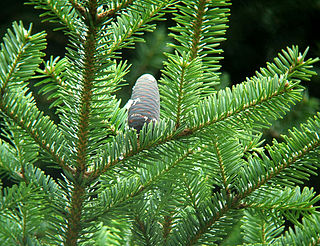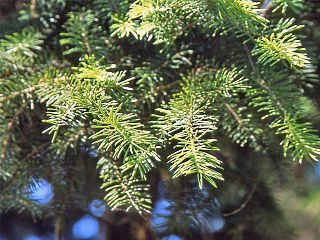
Picea jezoensis, the dark-bark spruce, Ezo spruce, Yezo spruce, or Jezo spruce, is a large evergreen tree growing to 30–50 m tall and with a trunk diameter of up to 2 m. It is native to northeast Asia, from the mountains of central Japan and the Changbai Mountains on the China-North Korea border, north to eastern Siberia, including the Sikhote-Alin, Kuril Islands, Sakhalin and Kamchatka. It is found in cold but humid temperate rain forests, and nowhere does its range extend more than 400 km from the Pacific Ocean. The specific epithet jezoensis derives from Ezo, an old name for Hokkaido and other islands north of the Japanese island of Honshu, where the species is found.

Abies homolepis, the Nikko fir is a fir native to the mountains of central and southern Honshū and Shikoku, Japan. It grows at altitudes of 700–2,200 m, often in temperate rain forest with high rainfall and cool, humid summers, and heavy winter snowfall.
Picea spinulosa, the Sikkim spruce, is a spruce native to the eastern Himalaya, in India (Sikkim), Nepal and Bhutan. It grows at altitudes of 2,400-3,700 m in mixed coniferous forests.

Picea meyeri is a species of spruce native to Nei Mongol in the northeast to Gansu in the southwest and also inhabiting Shanxi, Hebei and Shaanxi.

Picea koraiensis, the Korean spruce, is a species of spruce.
Abies fanjingshanensis is a species of conifer in the family Pinaceae. It is found only in China, on Fanjing Mountain in Guizhou Province. It is threatened by habitat loss.

Abies forrestii is a species of conifer in the family Pinaceae, endemic to China. It is named after the Scottish botanist and plant-hunter George Forrest (1873–1932), who discovered it for western science in Yunnan province. Its common names include Forrest's fir.

Abies recurvata is a species of conifer in the family Pinaceae. It is found only in China. Abies recurvata is a distinct fir species usually recognized by the needles on its leaders mostly recurved or reflexed. It occurs in the drier, colder northern regions of central China in Sichuan and Gansu provinces at elevations between 2300 and 3600 m, usually on windy cliffs or in deep river valleys. Sometimes, however, also appears in dry low scrub on exposed mountain slopes. The most typical associated conifer species include Juniperus convallium, Juniperus formosana var. mairei, Juniperus squamata var. fargesii, Juniperus tibetica, Picea asperata, and Picea wilsonii. Abies recurvata is a small to medium-sized tree mostly with conical crown, occasionally reaching a height of 40 m, and a trunk diameter of 0.8 metres. It has rather smooth gray or rusty brown bark, at first shedding in thin plates, becoming grayish-brown and detaching in thick plates. The branchlets are grayish-white or light yellow with 1.2–2.5 centimetres (0.47–0.98 in) long needles horizontally outspreading on shade branches, radially outspreading on fertile branches; often thick and recurved, green to gray above and densely set with stoma-lines, with 2 light grayish-green stomatal bands below. Abies recurvata has 4–8 centimetres (1.6–3.1 in) long ovoid or cylindrical-ovoid, gray- or purplish blue cones; the bracts are somewhat shorter than the cone-scales, included or with slightly exposed tips.

Abies spectabilis, the East Himalayan fir, is a conifer species in the family Pinaceae and the genus Abies. It is sometimes held to include the Bhutan fir as a variety. It is found in Afghanistan, China (Tibet), northern India, Nepal, and Pakistan. It is a large tree, up to 50 m (160 ft) tall.

Abies squamata is a species of conifer in the family Pinaceae. This fir is common in the Southeast of the Tibetan Plateau (China) in an altitude from 3200 m to tree-line in 4400 m. It is dominant on North-facing slopes and often grows with Balfour's spruce, Picea balfouriana. Government sector logging that was rampant until the logging ban in 1998 reduced fir stands significantly. Reforestation after the ban was dominated by spruce, since Abies squamata is susceptible to stem rot and thus shunned by the state forest bureaus. Undergrowth is most commonly dominated by members of the genus Rhododendron. Local Tibetans know this fir as "bollo", but that term is a general term for firs and spruces.
Abies yuanbaoshanensis is a species of fir tree in the family Pinaceae. It is found only in the Yuanbao Mountains within Guangxi province of China. It is a critically endangered species. It is estimated that only 700 trees exist, including saplings
Abies ziyuanensis is a species of fir, a conifer in the family Pinaceae. It is only known from four locations in Guangxi and Hunan provinces in China. A. ziyuanensis is related to Abies beshanzuensis, another threatened fir endemic to China.

Picea alcoquiana is a species of conifer in the family Pinaceae. It is native only to Japan.
Picea aurantiaca is a species of conifer in the pine family, Pinaceae. It is endemic to China, where it is only known from western Sichuan. Its common name is orange spruce.

Picea brachytyla is a species of conifer in the family Pinaceae. It is found in China and northeast India. It is threatened by habitat loss.
Picea farreri is a species of conifer in the pine family, Pinaceae. It is known by the common name Farrer's spruce. It is native to China, where it is known only from Yunnan, and to Myanmar.

Picea maximowiczii, the Japanese bush spruce, is a species of conifer in the pine family. It is endemic to Japan; its range is limited to Akaishi Mountains, Okuchichibu Mountains and the Yatsugatake Mountains on Honshu.

Picea morrisonicola, the Taiwan spruce, is a species of conifer in the family Pinaceae. It is found only in Taiwan, and it is the only species of spruce in Taiwan. It is the southernmost species of spruce genus in the world, being spread near the Tropic of Cancer, and, subsequently, is only thought to be hardy to USDA Zone 8. Taiwan spruce is a large tree, up to 50 m (160 ft) in height and 1.5 m in diameter. It grows at altitudes of about 2,000–2,500 m (6,600–8,200 ft) in the Central Mountain Range in ravines and mountain slopes, usually mixed with other trees.
Picea neoveitchii is a species of conifer in the family Pinaceae. It is found only in China. It is threatened by habitat loss.
Picea retroflexa, the Tapao Shan spruce, is a species of conifer in the family Pinaceae that is endemic to China, growing in West Sichuan, Kangding, Jiuzhaigou, Qinghai, and Ban Ma Xian. Its limited habitat is threatened by habitat loss due to logging, fires, and grazing.














